Analysis of Biodiversity Conservation Act
VerifiedAdded on 2019/09/26
|7
|1817
|241
Report
AI Summary
This report analyzes the Biodiversity Conservation Act in New South Wales, Australia. It examines the reforms implemented, including the repeal of previous acts like the Threatened Species Conservation Act 1995 and provisions of the National Parks and Wildlife Act 1974. The report details the $340 million investment over five years for private land conservation, species-saving programs, and strategic initiatives. A key focus is the shift from the Native Vegetation Act 2003's restrictive land clearance policies to a market-based approach, utilizing biodiversity offsets and a risk-based system. The analysis critically evaluates the government's arguments for the reform, weighing the claimed benefits of increased farmer flexibility against potential negative impacts on biodiversity and ecological sustainability. The report also discusses the three conditions necessary for the success of the market-based approach: improved farmer knowledge, a framework addressing regional spillover effects, and realistic discount rates. Finally, it highlights the act's provisions for private land conservation, species management, and enforcement, emphasizing the overall goal of ecologically sustainable development.
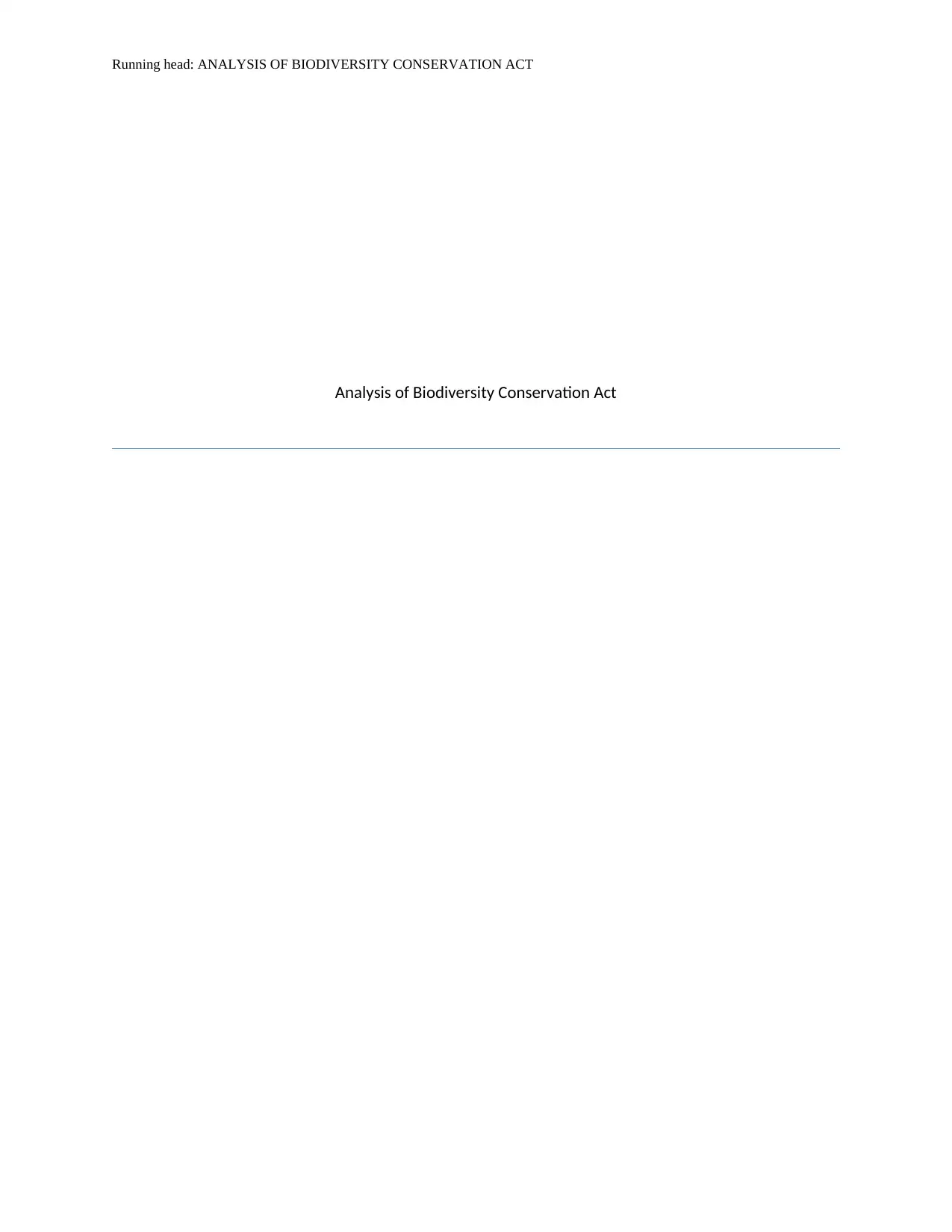
Running head: ANALYSIS OF BIODIVERSITY CONSERVATION ACT
Analysis of Biodiversity Conservation Act
Analysis of Biodiversity Conservation Act
Paraphrase This Document
Need a fresh take? Get an instant paraphrase of this document with our AI Paraphraser
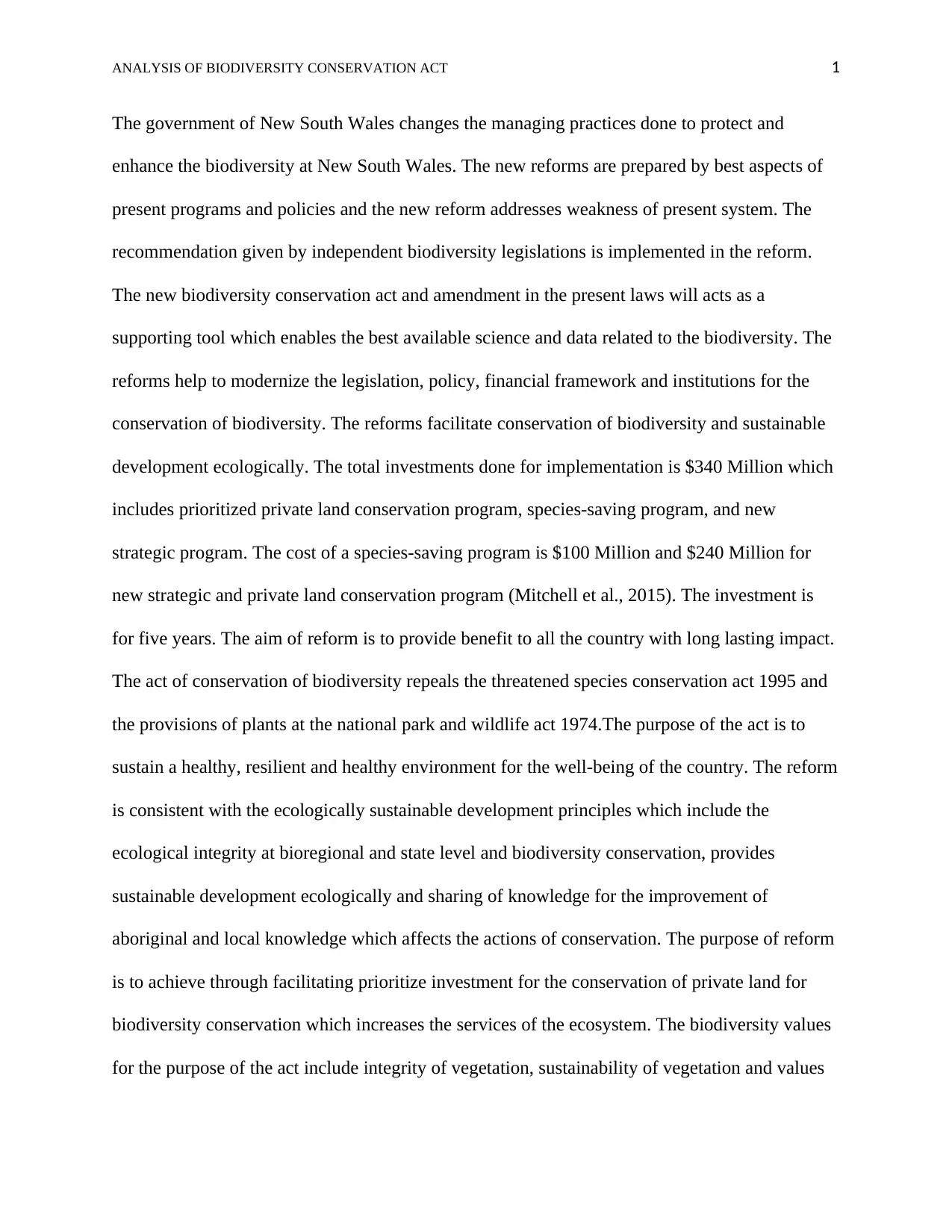
ANALYSIS OF BIODIVERSITY CONSERVATION ACT 1
The government of New South Wales changes the managing practices done to protect and
enhance the biodiversity at New South Wales. The new reforms are prepared by best aspects of
present programs and policies and the new reform addresses weakness of present system. The
recommendation given by independent biodiversity legislations is implemented in the reform.
The new biodiversity conservation act and amendment in the present laws will acts as a
supporting tool which enables the best available science and data related to the biodiversity. The
reforms help to modernize the legislation, policy, financial framework and institutions for the
conservation of biodiversity. The reforms facilitate conservation of biodiversity and sustainable
development ecologically. The total investments done for implementation is $340 Million which
includes prioritized private land conservation program, species-saving program, and new
strategic program. The cost of a species-saving program is $100 Million and $240 Million for
new strategic and private land conservation program (Mitchell et al., 2015). The investment is
for five years. The aim of reform is to provide benefit to all the country with long lasting impact.
The act of conservation of biodiversity repeals the threatened species conservation act 1995 and
the provisions of plants at the national park and wildlife act 1974.The purpose of the act is to
sustain a healthy, resilient and healthy environment for the well-being of the country. The reform
is consistent with the ecologically sustainable development principles which include the
ecological integrity at bioregional and state level and biodiversity conservation, provides
sustainable development ecologically and sharing of knowledge for the improvement of
aboriginal and local knowledge which affects the actions of conservation. The purpose of reform
is to achieve through facilitating prioritize investment for the conservation of private land for
biodiversity conservation which increases the services of the ecosystem. The biodiversity values
for the purpose of the act include integrity of vegetation, sustainability of vegetation and values
The government of New South Wales changes the managing practices done to protect and
enhance the biodiversity at New South Wales. The new reforms are prepared by best aspects of
present programs and policies and the new reform addresses weakness of present system. The
recommendation given by independent biodiversity legislations is implemented in the reform.
The new biodiversity conservation act and amendment in the present laws will acts as a
supporting tool which enables the best available science and data related to the biodiversity. The
reforms help to modernize the legislation, policy, financial framework and institutions for the
conservation of biodiversity. The reforms facilitate conservation of biodiversity and sustainable
development ecologically. The total investments done for implementation is $340 Million which
includes prioritized private land conservation program, species-saving program, and new
strategic program. The cost of a species-saving program is $100 Million and $240 Million for
new strategic and private land conservation program (Mitchell et al., 2015). The investment is
for five years. The aim of reform is to provide benefit to all the country with long lasting impact.
The act of conservation of biodiversity repeals the threatened species conservation act 1995 and
the provisions of plants at the national park and wildlife act 1974.The purpose of the act is to
sustain a healthy, resilient and healthy environment for the well-being of the country. The reform
is consistent with the ecologically sustainable development principles which include the
ecological integrity at bioregional and state level and biodiversity conservation, provides
sustainable development ecologically and sharing of knowledge for the improvement of
aboriginal and local knowledge which affects the actions of conservation. The purpose of reform
is to achieve through facilitating prioritize investment for the conservation of private land for
biodiversity conservation which increases the services of the ecosystem. The biodiversity values
for the purpose of the act include integrity of vegetation, sustainability of vegetation and values
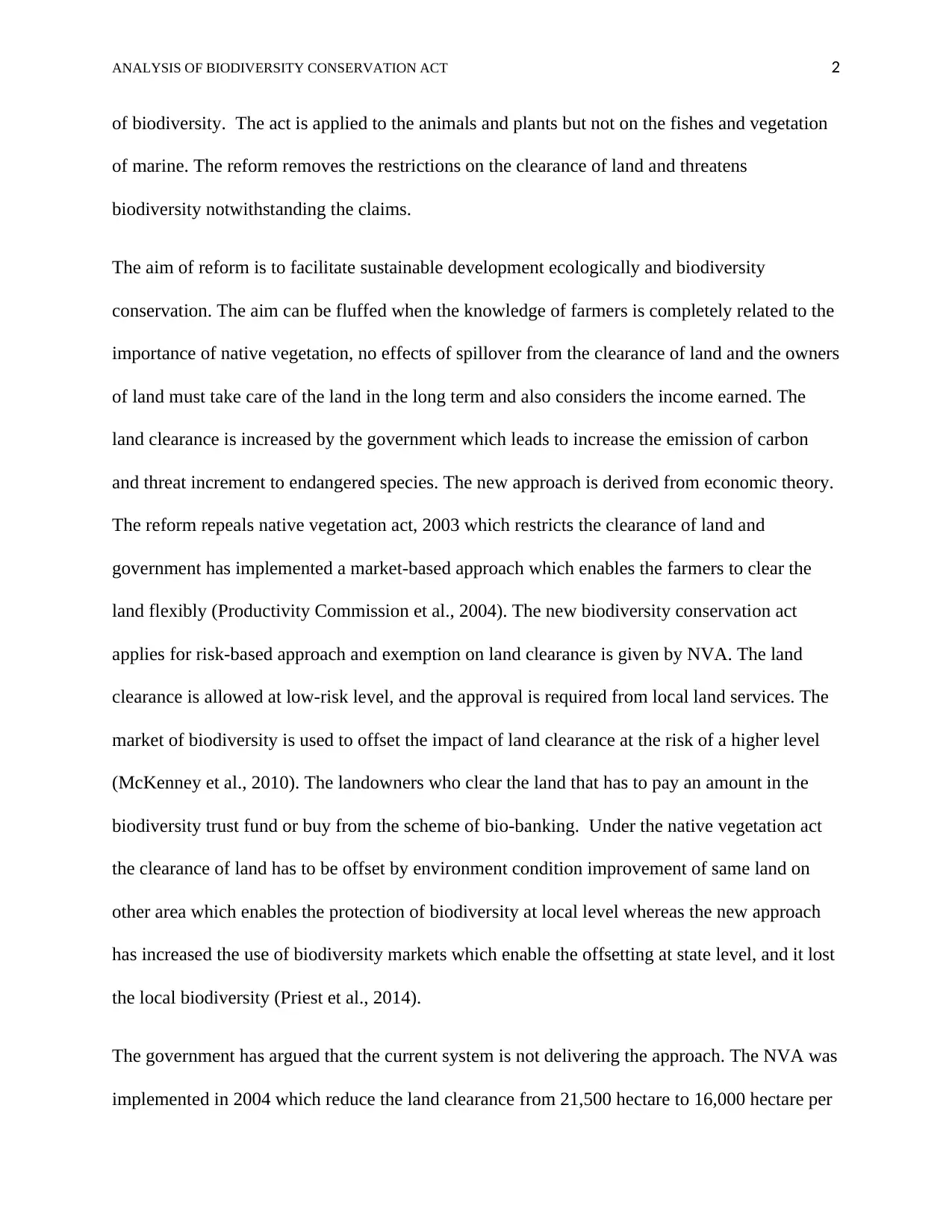
ANALYSIS OF BIODIVERSITY CONSERVATION ACT 2
of biodiversity. The act is applied to the animals and plants but not on the fishes and vegetation
of marine. The reform removes the restrictions on the clearance of land and threatens
biodiversity notwithstanding the claims.
The aim of reform is to facilitate sustainable development ecologically and biodiversity
conservation. The aim can be fluffed when the knowledge of farmers is completely related to the
importance of native vegetation, no effects of spillover from the clearance of land and the owners
of land must take care of the land in the long term and also considers the income earned. The
land clearance is increased by the government which leads to increase the emission of carbon
and threat increment to endangered species. The new approach is derived from economic theory.
The reform repeals native vegetation act, 2003 which restricts the clearance of land and
government has implemented a market-based approach which enables the farmers to clear the
land flexibly (Productivity Commission et al., 2004). The new biodiversity conservation act
applies for risk-based approach and exemption on land clearance is given by NVA. The land
clearance is allowed at low-risk level, and the approval is required from local land services. The
market of biodiversity is used to offset the impact of land clearance at the risk of a higher level
(McKenney et al., 2010). The landowners who clear the land that has to pay an amount in the
biodiversity trust fund or buy from the scheme of bio-banking. Under the native vegetation act
the clearance of land has to be offset by environment condition improvement of same land on
other area which enables the protection of biodiversity at local level whereas the new approach
has increased the use of biodiversity markets which enable the offsetting at state level, and it lost
the local biodiversity (Priest et al., 2014).
The government has argued that the current system is not delivering the approach. The NVA was
implemented in 2004 which reduce the land clearance from 21,500 hectare to 16,000 hectare per
of biodiversity. The act is applied to the animals and plants but not on the fishes and vegetation
of marine. The reform removes the restrictions on the clearance of land and threatens
biodiversity notwithstanding the claims.
The aim of reform is to facilitate sustainable development ecologically and biodiversity
conservation. The aim can be fluffed when the knowledge of farmers is completely related to the
importance of native vegetation, no effects of spillover from the clearance of land and the owners
of land must take care of the land in the long term and also considers the income earned. The
land clearance is increased by the government which leads to increase the emission of carbon
and threat increment to endangered species. The new approach is derived from economic theory.
The reform repeals native vegetation act, 2003 which restricts the clearance of land and
government has implemented a market-based approach which enables the farmers to clear the
land flexibly (Productivity Commission et al., 2004). The new biodiversity conservation act
applies for risk-based approach and exemption on land clearance is given by NVA. The land
clearance is allowed at low-risk level, and the approval is required from local land services. The
market of biodiversity is used to offset the impact of land clearance at the risk of a higher level
(McKenney et al., 2010). The landowners who clear the land that has to pay an amount in the
biodiversity trust fund or buy from the scheme of bio-banking. Under the native vegetation act
the clearance of land has to be offset by environment condition improvement of same land on
other area which enables the protection of biodiversity at local level whereas the new approach
has increased the use of biodiversity markets which enable the offsetting at state level, and it lost
the local biodiversity (Priest et al., 2014).
The government has argued that the current system is not delivering the approach. The NVA was
implemented in 2004 which reduce the land clearance from 21,500 hectare to 16,000 hectare per
⊘ This is a preview!⊘
Do you want full access?
Subscribe today to unlock all pages.

Trusted by 1+ million students worldwide
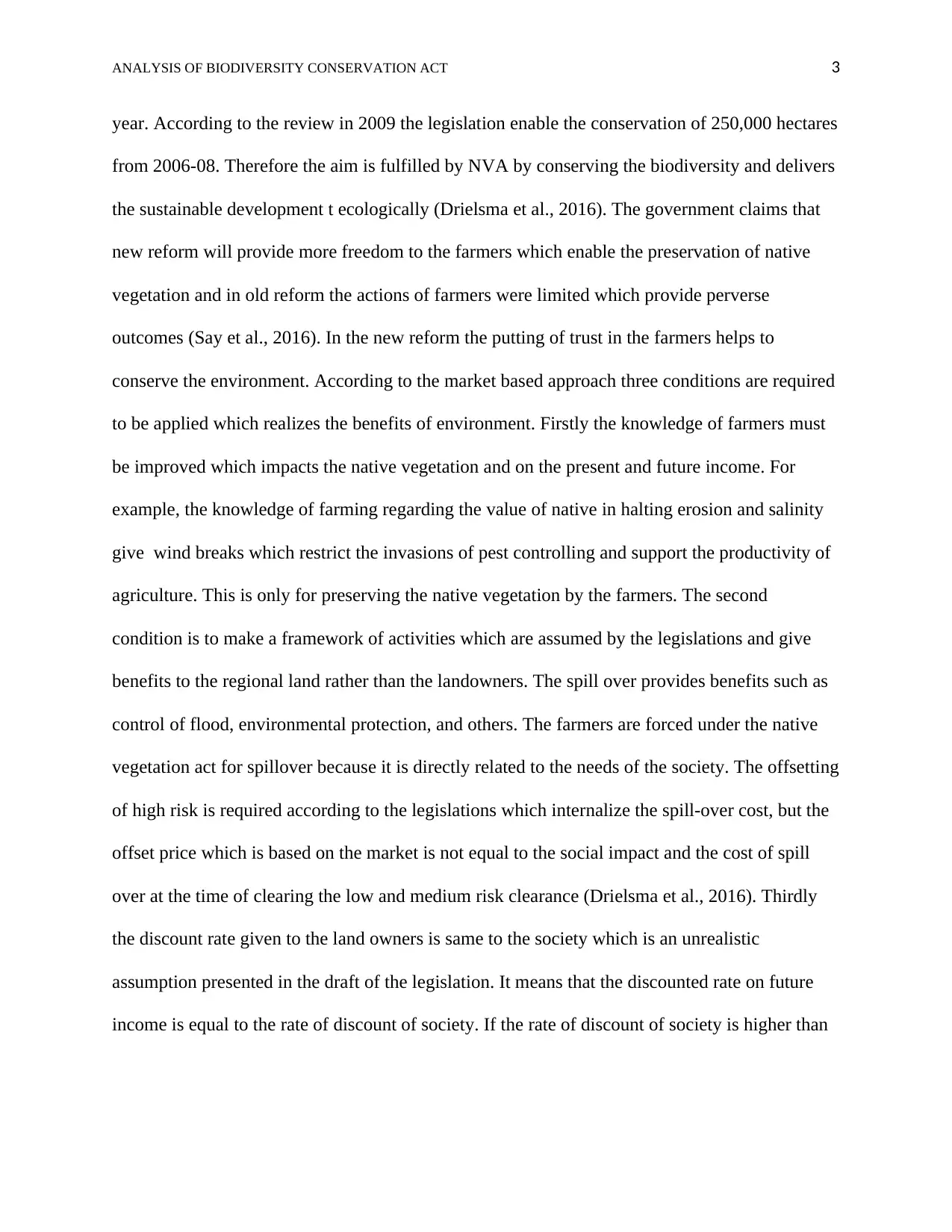
ANALYSIS OF BIODIVERSITY CONSERVATION ACT 3
year. According to the review in 2009 the legislation enable the conservation of 250,000 hectares
from 2006-08. Therefore the aim is fulfilled by NVA by conserving the biodiversity and delivers
the sustainable development t ecologically (Drielsma et al., 2016). The government claims that
new reform will provide more freedom to the farmers which enable the preservation of native
vegetation and in old reform the actions of farmers were limited which provide perverse
outcomes (Say et al., 2016). In the new reform the putting of trust in the farmers helps to
conserve the environment. According to the market based approach three conditions are required
to be applied which realizes the benefits of environment. Firstly the knowledge of farmers must
be improved which impacts the native vegetation and on the present and future income. For
example, the knowledge of farming regarding the value of native in halting erosion and salinity
give wind breaks which restrict the invasions of pest controlling and support the productivity of
agriculture. This is only for preserving the native vegetation by the farmers. The second
condition is to make a framework of activities which are assumed by the legislations and give
benefits to the regional land rather than the landowners. The spill over provides benefits such as
control of flood, environmental protection, and others. The farmers are forced under the native
vegetation act for spillover because it is directly related to the needs of the society. The offsetting
of high risk is required according to the legislations which internalize the spill-over cost, but the
offset price which is based on the market is not equal to the social impact and the cost of spill
over at the time of clearing the low and medium risk clearance (Drielsma et al., 2016). Thirdly
the discount rate given to the land owners is same to the society which is an unrealistic
assumption presented in the draft of the legislation. It means that the discounted rate on future
income is equal to the rate of discount of society. If the rate of discount of society is higher than
year. According to the review in 2009 the legislation enable the conservation of 250,000 hectares
from 2006-08. Therefore the aim is fulfilled by NVA by conserving the biodiversity and delivers
the sustainable development t ecologically (Drielsma et al., 2016). The government claims that
new reform will provide more freedom to the farmers which enable the preservation of native
vegetation and in old reform the actions of farmers were limited which provide perverse
outcomes (Say et al., 2016). In the new reform the putting of trust in the farmers helps to
conserve the environment. According to the market based approach three conditions are required
to be applied which realizes the benefits of environment. Firstly the knowledge of farmers must
be improved which impacts the native vegetation and on the present and future income. For
example, the knowledge of farming regarding the value of native in halting erosion and salinity
give wind breaks which restrict the invasions of pest controlling and support the productivity of
agriculture. This is only for preserving the native vegetation by the farmers. The second
condition is to make a framework of activities which are assumed by the legislations and give
benefits to the regional land rather than the landowners. The spill over provides benefits such as
control of flood, environmental protection, and others. The farmers are forced under the native
vegetation act for spillover because it is directly related to the needs of the society. The offsetting
of high risk is required according to the legislations which internalize the spill-over cost, but the
offset price which is based on the market is not equal to the social impact and the cost of spill
over at the time of clearing the low and medium risk clearance (Drielsma et al., 2016). Thirdly
the discount rate given to the land owners is same to the society which is an unrealistic
assumption presented in the draft of the legislation. It means that the discounted rate on future
income is equal to the rate of discount of society. If the rate of discount of society is higher than
Paraphrase This Document
Need a fresh take? Get an instant paraphrase of this document with our AI Paraphraser
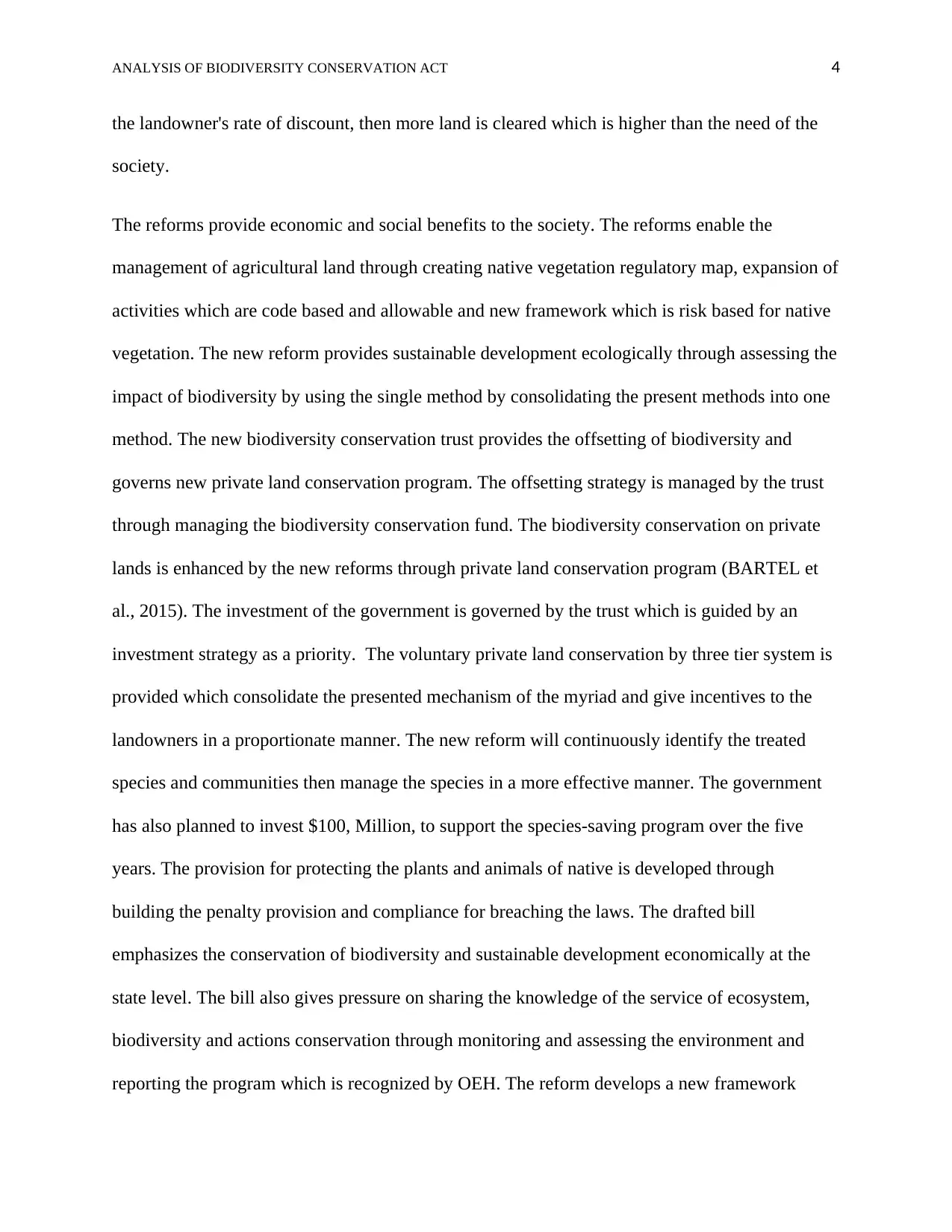
ANALYSIS OF BIODIVERSITY CONSERVATION ACT 4
the landowner's rate of discount, then more land is cleared which is higher than the need of the
society.
The reforms provide economic and social benefits to the society. The reforms enable the
management of agricultural land through creating native vegetation regulatory map, expansion of
activities which are code based and allowable and new framework which is risk based for native
vegetation. The new reform provides sustainable development ecologically through assessing the
impact of biodiversity by using the single method by consolidating the present methods into one
method. The new biodiversity conservation trust provides the offsetting of biodiversity and
governs new private land conservation program. The offsetting strategy is managed by the trust
through managing the biodiversity conservation fund. The biodiversity conservation on private
lands is enhanced by the new reforms through private land conservation program (BARTEL et
al., 2015). The investment of the government is governed by the trust which is guided by an
investment strategy as a priority. The voluntary private land conservation by three tier system is
provided which consolidate the presented mechanism of the myriad and give incentives to the
landowners in a proportionate manner. The new reform will continuously identify the treated
species and communities then manage the species in a more effective manner. The government
has also planned to invest $100, Million, to support the species-saving program over the five
years. The provision for protecting the plants and animals of native is developed through
building the penalty provision and compliance for breaching the laws. The drafted bill
emphasizes the conservation of biodiversity and sustainable development economically at the
state level. The bill also gives pressure on sharing the knowledge of the service of ecosystem,
biodiversity and actions conservation through monitoring and assessing the environment and
reporting the program which is recognized by OEH. The reform develops a new framework
the landowner's rate of discount, then more land is cleared which is higher than the need of the
society.
The reforms provide economic and social benefits to the society. The reforms enable the
management of agricultural land through creating native vegetation regulatory map, expansion of
activities which are code based and allowable and new framework which is risk based for native
vegetation. The new reform provides sustainable development ecologically through assessing the
impact of biodiversity by using the single method by consolidating the present methods into one
method. The new biodiversity conservation trust provides the offsetting of biodiversity and
governs new private land conservation program. The offsetting strategy is managed by the trust
through managing the biodiversity conservation fund. The biodiversity conservation on private
lands is enhanced by the new reforms through private land conservation program (BARTEL et
al., 2015). The investment of the government is governed by the trust which is guided by an
investment strategy as a priority. The voluntary private land conservation by three tier system is
provided which consolidate the presented mechanism of the myriad and give incentives to the
landowners in a proportionate manner. The new reform will continuously identify the treated
species and communities then manage the species in a more effective manner. The government
has also planned to invest $100, Million, to support the species-saving program over the five
years. The provision for protecting the plants and animals of native is developed through
building the penalty provision and compliance for breaching the laws. The drafted bill
emphasizes the conservation of biodiversity and sustainable development economically at the
state level. The bill also gives pressure on sharing the knowledge of the service of ecosystem,
biodiversity and actions conservation through monitoring and assessing the environment and
reporting the program which is recognized by OEH. The reform develops a new framework
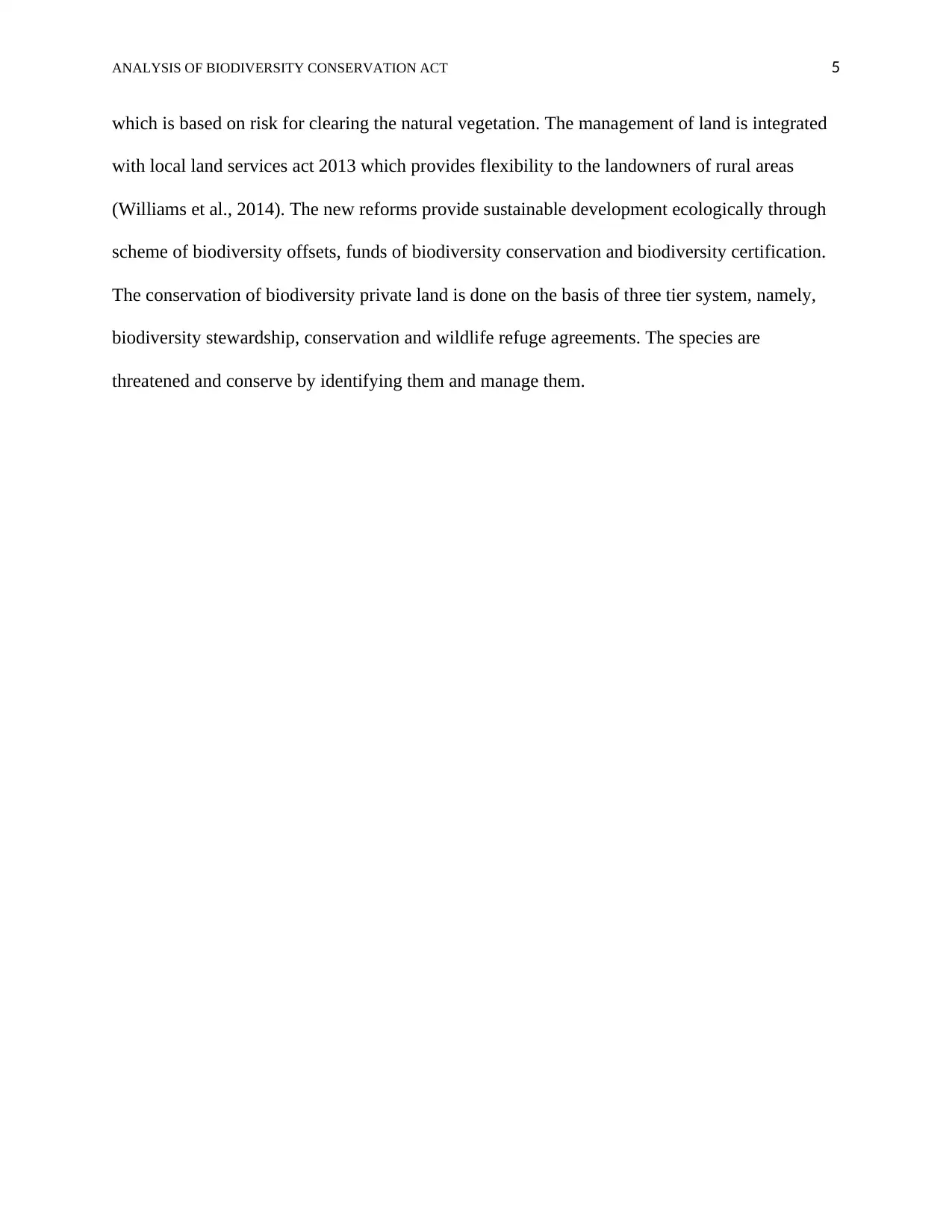
ANALYSIS OF BIODIVERSITY CONSERVATION ACT 5
which is based on risk for clearing the natural vegetation. The management of land is integrated
with local land services act 2013 which provides flexibility to the landowners of rural areas
(Williams et al., 2014). The new reforms provide sustainable development ecologically through
scheme of biodiversity offsets, funds of biodiversity conservation and biodiversity certification.
The conservation of biodiversity private land is done on the basis of three tier system, namely,
biodiversity stewardship, conservation and wildlife refuge agreements. The species are
threatened and conserve by identifying them and manage them.
which is based on risk for clearing the natural vegetation. The management of land is integrated
with local land services act 2013 which provides flexibility to the landowners of rural areas
(Williams et al., 2014). The new reforms provide sustainable development ecologically through
scheme of biodiversity offsets, funds of biodiversity conservation and biodiversity certification.
The conservation of biodiversity private land is done on the basis of three tier system, namely,
biodiversity stewardship, conservation and wildlife refuge agreements. The species are
threatened and conserve by identifying them and manage them.
⊘ This is a preview!⊘
Do you want full access?
Subscribe today to unlock all pages.

Trusted by 1+ million students worldwide
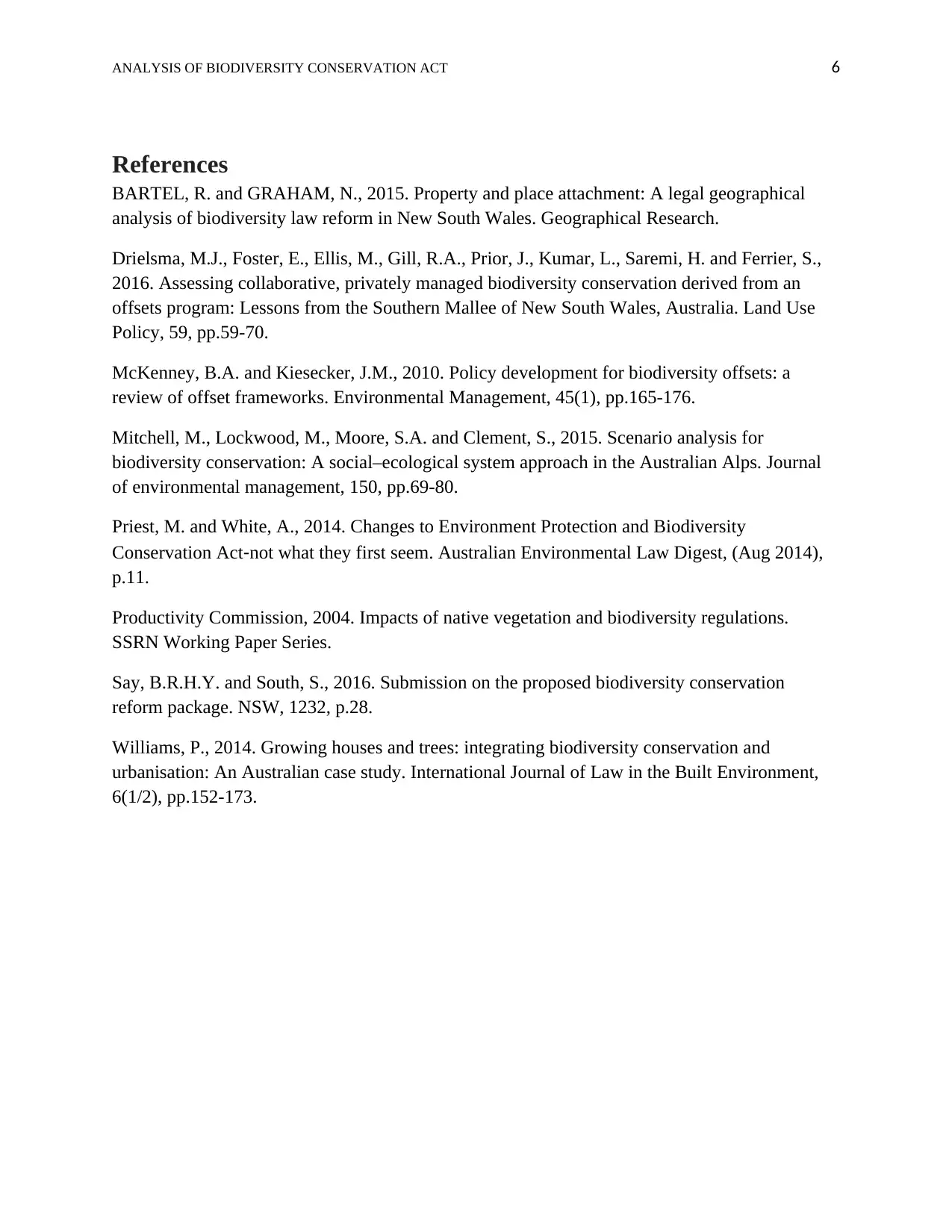
ANALYSIS OF BIODIVERSITY CONSERVATION ACT 6
References
BARTEL, R. and GRAHAM, N., 2015. Property and place attachment: A legal geographical
analysis of biodiversity law reform in New South Wales. Geographical Research.
Drielsma, M.J., Foster, E., Ellis, M., Gill, R.A., Prior, J., Kumar, L., Saremi, H. and Ferrier, S.,
2016. Assessing collaborative, privately managed biodiversity conservation derived from an
offsets program: Lessons from the Southern Mallee of New South Wales, Australia. Land Use
Policy, 59, pp.59-70.
McKenney, B.A. and Kiesecker, J.M., 2010. Policy development for biodiversity offsets: a
review of offset frameworks. Environmental Management, 45(1), pp.165-176.
Mitchell, M., Lockwood, M., Moore, S.A. and Clement, S., 2015. Scenario analysis for
biodiversity conservation: A social–ecological system approach in the Australian Alps. Journal
of environmental management, 150, pp.69-80.
Priest, M. and White, A., 2014. Changes to Environment Protection and Biodiversity
Conservation Act‐not what they first seem. Australian Environmental Law Digest, (Aug 2014),
p.11.
Productivity Commission, 2004. Impacts of native vegetation and biodiversity regulations.
SSRN Working Paper Series.
Say, B.R.H.Y. and South, S., 2016. Submission on the proposed biodiversity conservation
reform package. NSW, 1232, p.28.
Williams, P., 2014. Growing houses and trees: integrating biodiversity conservation and
urbanisation: An Australian case study. International Journal of Law in the Built Environment,
6(1/2), pp.152-173.
References
BARTEL, R. and GRAHAM, N., 2015. Property and place attachment: A legal geographical
analysis of biodiversity law reform in New South Wales. Geographical Research.
Drielsma, M.J., Foster, E., Ellis, M., Gill, R.A., Prior, J., Kumar, L., Saremi, H. and Ferrier, S.,
2016. Assessing collaborative, privately managed biodiversity conservation derived from an
offsets program: Lessons from the Southern Mallee of New South Wales, Australia. Land Use
Policy, 59, pp.59-70.
McKenney, B.A. and Kiesecker, J.M., 2010. Policy development for biodiversity offsets: a
review of offset frameworks. Environmental Management, 45(1), pp.165-176.
Mitchell, M., Lockwood, M., Moore, S.A. and Clement, S., 2015. Scenario analysis for
biodiversity conservation: A social–ecological system approach in the Australian Alps. Journal
of environmental management, 150, pp.69-80.
Priest, M. and White, A., 2014. Changes to Environment Protection and Biodiversity
Conservation Act‐not what they first seem. Australian Environmental Law Digest, (Aug 2014),
p.11.
Productivity Commission, 2004. Impacts of native vegetation and biodiversity regulations.
SSRN Working Paper Series.
Say, B.R.H.Y. and South, S., 2016. Submission on the proposed biodiversity conservation
reform package. NSW, 1232, p.28.
Williams, P., 2014. Growing houses and trees: integrating biodiversity conservation and
urbanisation: An Australian case study. International Journal of Law in the Built Environment,
6(1/2), pp.152-173.
1 out of 7
Related Documents
Your All-in-One AI-Powered Toolkit for Academic Success.
+13062052269
info@desklib.com
Available 24*7 on WhatsApp / Email
![[object Object]](/_next/static/media/star-bottom.7253800d.svg)
Unlock your academic potential
Copyright © 2020–2025 A2Z Services. All Rights Reserved. Developed and managed by ZUCOL.





